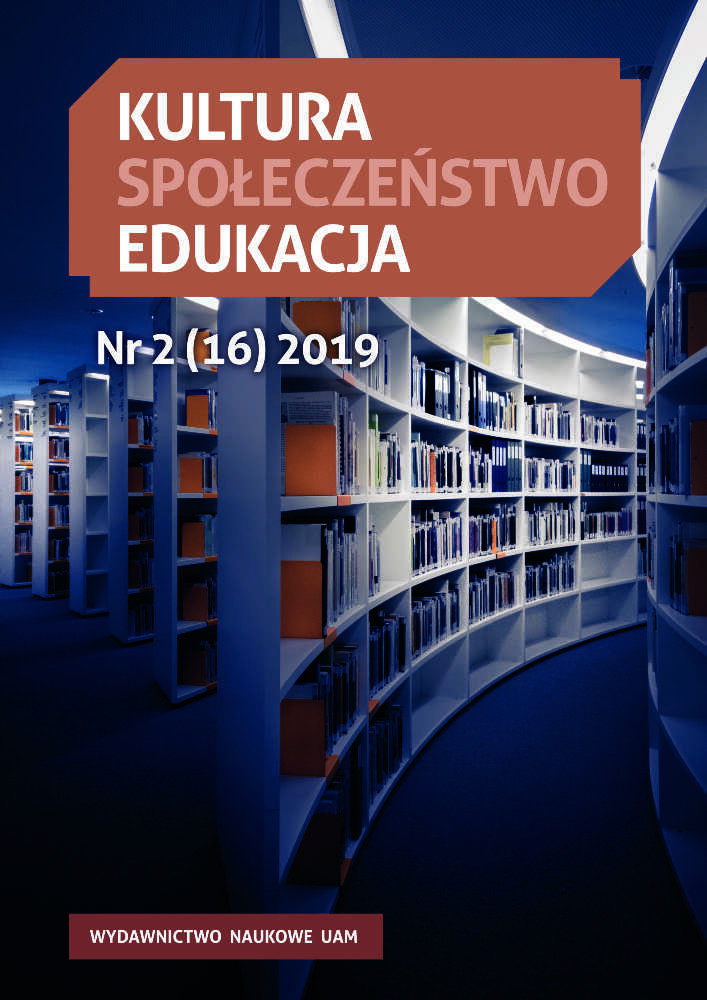Abstrakt
Kaźmierczak Monika, Wichurska Karina, The specificity and determinants of speech-language therapy with a patient after ischemic stroke. Case study. Culture – Society – Education no 2(16) 2019, Poznań 2019, pp. 133–147, Adam Mickiewicz University Press. ISSN 2300-0422. DOI 10.14746/kse.2019.16.9.
Patients with ischemic brain injury may be affected by damage of brain centers responsible for speech, which is the cause of aphasia. Because the disintegration of linguistic and communication skills makes it difficult or even impossible to communicate with the environment effectively, every patient with aphasia requires speech therapy. In diagnosing aphasia, a qualitative approach is desirable. Presented case proves that the main goal of reeducation of a patient who has lost the ability to communicate with the environment is first to restore this contact in the simplest form, and then gradually rebuild various types of competences and improve implementation, using adequate methods, techniques and tools. All activities, taking into account the possibilities
and limitations of the patient and adapted to the dynamics of her speech disorder, were aimed at improving the quality of patient’s life and becoming more independent, so that she could successfully participate in social life.
Bibliografia
Balejko A. (2005), Test nazywania. Diagnoza i terapia osób z zaburzeniami mowy, Białystok.
Cwietkowa L.S. (1985), Niejropsichołogiczieskaja reabilitacija bol’nych. Riecz i intielektualnaja diejatel’nost’, Moskva.
Grabias S. (2014), Mowa i jej zaburzenia, [in:] S. Grabias, M. Kurkowski (eds.), Logopedia. Teoria zaburzeń mowy, Lublin, pp. 15–71.
International Statistical Classification of Diseases and Related Health Problems, ICD-10, vol. I (2009), World Health Organization.
Jastrzębowska G. (1998), Podstawy teorii i diagnozy logopedycznej, Opole.
Kaźmierczak M., Wichurska K. (2018), Dynamika obrazu zaburzeń mowy u pacjentki po udarze niedokrwiennym mózgu – opis przypadku, Otorynolaryngologia no. 2, pp. 72–79.
Knychalska-Zbierańska M. (2014), Afazja – złodziejka słów. Studium przypadku, Logopedia Silesiana 3, pp. 271–284.
Lewicka T., Stompel D., Nowakowska-Kempna I. (2014), Zaburzenia językowe w chorobach neurodegeneracyjnych – aspekty diagnostyczne i terapeutyczne, Logopedia Silesiana 3, pp. 76–94.
Maruszewski M. (1974), Chory z afazją i jego usprawnianie, Warszawa.
Nowakowska M. T. (ed.) (1978), Rehabilitacja chorych z afazją, Wrocław.
Panasiuk J. (2014), Afazja – typologia zaburzenia. Interpretacja afazji z perspektywy interakcyjnej, [in:] S. Grabias, M. Kurkowski (eds.), Logopedia. Teoria zaburzeń mowy, Lublin, pp. 569–621.
Panasiuk J. (2015), Postępowanie logopedyczne w przypadkach afazji, [in:] S. Grabias, J. Panasiuk, T. Woźniak (eds.), Logopedia. Standardy postępowania logopedycznego, Lublin, pp. 869–916.
Pąchalska M. (2005), Neuropsychologiczna diagnostyka afazji, [in:] E. Szeląg, I. Gałkowski, G. Jastrzebowska (eds.), Podstawy neurologopedii, Opole, pp. 750–845.
Pąchalska M. (2008), Rehabilitacja neuropsychologiczna, Lublin.
Pąchalska M. (2011), Patogeneza i neuropsychologiczna diagnostyka afazji, [in:] Ł. Domańska, A. Borkowska (eds.). Podstawy neuropsychologii klinicznej, Lublin, pp. 153–194.
Pohjasvaara T. at al. (1998), Clinical determinants of poststroke dementia, Stroke no. 29, pp. 75–81.
Raciborski F., Gujski M. (eds.) (2016), Udary mózgu – rosnący problem w starzejącym się społeczeństwie. Raport Instytutu Ochrony Zdrowia, Warszawa.
Ryglewicz D., Milewska D. (2004), Epidemiologia afazji u chorych z udarem mózgu, Udar Mózgu no. 2, pp. 65–70.
Sacco R.L., at al. (2013), An updated definition of stroke for the 21st century: a statement for healthcare professionals from the American Heart Association/American Stroke Association, Stroke nr 44, pp. 2064‒2089.
Sadowski B., Chmurzyński J.A. (1989), Biologiczne mechanizmy zachowania, Warszawa.
Siminska J., at al. (2016), Udar niedokrwienny mózgu – postępowanie przedszpitalne i wczesnoszpitalne, Journal of Education, Health and Sport no. 8, pp. 439–453.
Tatemichi T.K., at al. (1994), Cognitive impairment after stroke: frequency, patterns, and relationship to functional abilities, Journal of Neurology, Neurosurgery, and Psychiatry no. 57, pp. 202–207.
Wade D.T. at al. (1986), Aphasia after stroke: natural history and associated deficits, Journal of Neurology, Neurosurgery, and Psychiatry no. 49, pp. 11–16.
Walsh K. (1997), Neuropsychologia kliniczna, Warszawa.
Licencja
Prawa autorskie (c) 2020 Kaźmierczak Monika, Karina Wichurska

Utwór dostępny jest na licencji Creative Commons Uznanie autorstwa – Bez utworów zależnych 4.0 Międzynarodowe.
